From the servo example I took a hint and implemented this basic leg:

import sys
import pygame
from pygame.locals import USEREVENT, QUIT, KEYDOWN, KEYUP, K_s, K_r, K_q, K_ESCAPE, K_UP, K_DOWN, K_RIGHT, K_LEFT
from pygame.color import THECOLORS
import pymunk
from pymunk import Vec2d
import pymunk.pygame_util
class Simulator(object):
def __init__(self):
self.display_flags = 0
self.display_size = (600, 600)
self.space = pymunk.Space()
self.space.gravity = (0.0, -1900.0)
#self.space.damping = 0.999 # to prevent it from blowing up.
# Pymunk physics coordinates start from the lower right-hand corner of the screen.
self.ground_y = 100
ground = pymunk.Segment(self.space.static_body, (5, self.ground_y), (595, self.ground_y), 1.0)
ground.friction = 1.0
self.space.add(ground)
self.screen = None
self.draw_options = None
def reset_bodies(self):
for body in self.space.bodies:
if not hasattr(body, 'start_position'):
continue
body.position = Vec2d(body.start_position)
body.force = 0, 0
body.torque = 0
body.velocity = 0, 0
body.angular_velocity = 0
body.angle = body.start_angle
def draw(self):
self.screen.fill(THECOLORS["white"])### Clear the screen
self.space.debug_draw(self.draw_options)### Draw space
pygame.display.flip()### All done, lets flip the display
def main(self):
pygame.init()
self.screen = pygame.display.set_mode(self.display_size, self.display_flags)
width, height = self.screen.get_size()
self.draw_options = pymunk.pygame_util.DrawOptions(self.screen)
def to_pygame(p):
return int(p.x), int(-p.y+height) #Small hack to convert pymunk to pygame coordinates
def from_pygame(p):
return to_pygame(p)
clock = pygame.time.Clock()
running = True
font = pygame.font.Font(None, 16)
# Create the spider
chassisXY = Vec2d(self.display_size[0]/2, self.ground_y+100)
chWd = 70; chHt = 50
chassisMass = 10
legWd_a = 50; legHt_a = 5
legWd_b = 100; legHt_b = 5
legMass = 1
relativeAnguVel = 0
#---chassis
chassis_b = pymunk.Body(chassisMass, pymunk.moment_for_box(chassisMass, (chWd, chHt)))
chassis_b.position = chassisXY
chassis_shape = pymunk.Poly.create_box(chassis_b, (chWd, chHt))
chassis_shape.color = 200, 200, 200, 100
print("chassis position");print(chassis_b.position)
#---first left leg a
leftLeg_1a_body = pymunk.Body(legMass, pymunk.moment_for_box(legMass, (legWd_a, legHt_a)))
leftLeg_1a_body.position = chassisXY - ((chWd/2)+(legWd_a/2), 0)
leftLeg_1a_shape = pymunk.Poly.create_box(leftLeg_1a_body, (legWd_a, legHt_a))
leftLeg_1a_shape.color = 255, 0, 0, 100
#---first left leg b
leftLeg_1b_body = pymunk.Body(legMass, pymunk.moment_for_box(legMass, (legWd_b, legHt_b)))
leftLeg_1b_body.position = leftLeg_1a_body.position - ((legWd_a/2)+(legWd_b/2), 0)
leftLeg_1b_shape = pymunk.Poly.create_box(leftLeg_1b_body, (legWd_b, legHt_b))
leftLeg_1b_shape.color = 0, 255, 0, 100
#---first right leg a
rightLeg_1a_body = pymunk.Body(legMass, pymunk.moment_for_box(legMass, (legWd_a, legHt_a)))
rightLeg_1a_body.position = chassisXY + ((chWd/2)+(legWd_a/2), 0)
rightLeg_1a_shape = pymunk.Poly.create_box(rightLeg_1a_body, (legWd_a, legHt_a))
rightLeg_1a_shape.color = 255, 0, 0, 100
#---first right leg b
rightLeg_1b_body = pymunk.Body(legMass, pymunk.moment_for_box(legMass, (legWd_b, legHt_b)))
rightLeg_1b_body.position = rightLeg_1a_body.position + ((legWd_a/2)+(legWd_b/2), 0)
rightLeg_1b_shape = pymunk.Poly.create_box(rightLeg_1b_body, (legWd_b, legHt_b))
rightLeg_1b_shape.color = 0, 255, 0, 100
#---link left leg b with left leg a
pj_ba1left = pymunk.PinJoint(leftLeg_1b_body, leftLeg_1a_body, (legWd_b/2,0), (-legWd_a/2,0))#anchor point coordinates are wrt the body; not the space
motor_ba1Left = pymunk.SimpleMotor(leftLeg_1b_body, leftLeg_1a_body, relativeAnguVel)
#---link left leg a with chassis
pj_ac1left = pymunk.PinJoint(leftLeg_1a_body, chassis_b, (legWd_a/2,0), (-chWd/2, 0))
motor_ac1Left = pymunk.SimpleMotor(leftLeg_1a_body, chassis_b, relativeAnguVel)
#---link right leg b with right leg a
pj_ba1Right = pymunk.PinJoint(rightLeg_1b_body, rightLeg_1a_body, (-legWd_b/2,0), (legWd_a/2,0))#anchor point coordinates are wrt the body; not the space
motor_ba1Right = pymunk.SimpleMotor(rightLeg_1b_body, rightLeg_1a_body, relativeAnguVel)
#---link right leg a with chassis
pj_ac1Right = pymunk.PinJoint(rightLeg_1a_body, chassis_b, (-legWd_a/2,0), (chWd/2, 0))
motor_ac1Right = pymunk.SimpleMotor(rightLeg_1a_body, chassis_b, relativeAnguVel)
self.space.add(chassis_b, chassis_shape)
self.space.add(leftLeg_1a_body, leftLeg_1a_shape, rightLeg_1a_body, rightLeg_1a_shape)
self.space.add(leftLeg_1b_body, leftLeg_1b_shape, rightLeg_1b_body, rightLeg_1b_shape)
self.space.add(pj_ba1left, motor_ba1Left, pj_ac1left, motor_ac1Left)
self.space.add(pj_ba1Right, motor_ba1Right, pj_ac1Right, motor_ac1Right)
#---prevent collisions with ShapeFilter
shape_filter = pymunk.ShapeFilter(group=1)
chassis_shape.filter = shape_filter
leftLeg_1a_shape.filter = shape_filter
rightLeg_1a_shape.filter = shape_filter
leftLeg_1b_shape.filter = shape_filter
rightLeg_1b_shape.filter = shape_filter
simulate = False
rotationRate = 2
while running:
for event in pygame.event.get():
if event.type == QUIT or (event.type == KEYDOWN and event.key in (K_q, K_ESCAPE)):
#running = False
sys.exit(0)
elif event.type == KEYDOWN and event.key == K_s:
# Start/stop simulation.
simulate = not simulate
elif event.type == KEYDOWN and event.key == K_r:
# Reset.
# simulate = False
self.reset_bodies()
elif event.type == KEYDOWN and event.key == K_UP:
motor_ba1Left.rate = rotationRate
elif event.type == KEYDOWN and event.key == K_DOWN:
motor_ba1Left.rate = -rotationRate
elif event.type == KEYDOWN and event.key == K_LEFT:
motor_ac1Left.rate = rotationRate
elif event.type == KEYDOWN and event.key == K_RIGHT:
motor_ac1Left.rate = -rotationRate
elif event.type == KEYUP:
motor_ba1Left.rate = 0
motor_ac1Left.rate = 0
self.draw()
### Update physics
fps = 50
iterations = 25
dt = 1.0/float(fps)/float(iterations)
if simulate:
for x in range(iterations): # 10 iterations to get a more stable simulation
self.space.step(dt)
pygame.display.flip()
clock.tick(fps)
if __name__ == '__main__':
sim = Simulator()
sim.main()
It can be controlled with the up, left, right and down arrow keys after first pressing the s key to start the simulation. I've also made sure the variables are created properly linked with each other and named well.
The part about making the joints move to a desired angle is yet to be implemented, but perhaps that could be calculated by taking the x,y positions of the ends of the joints and using a formula to calculate the angle and then move the motor until it reaches a desired angle.
If there's a better way, do let me know by posting an answer or editing this one.

